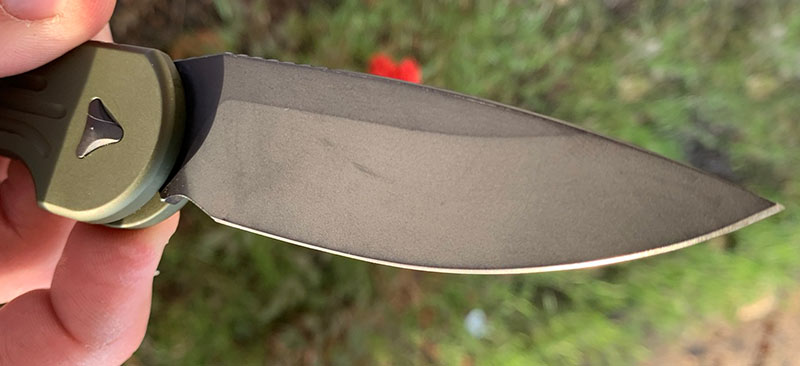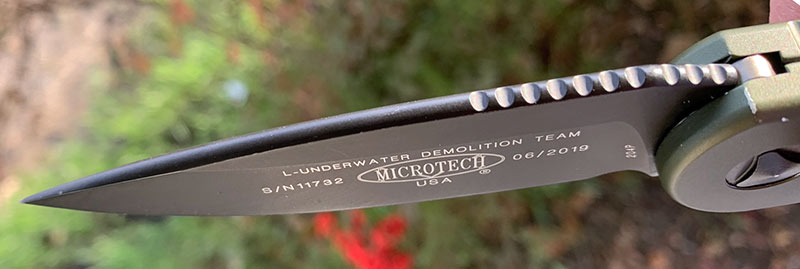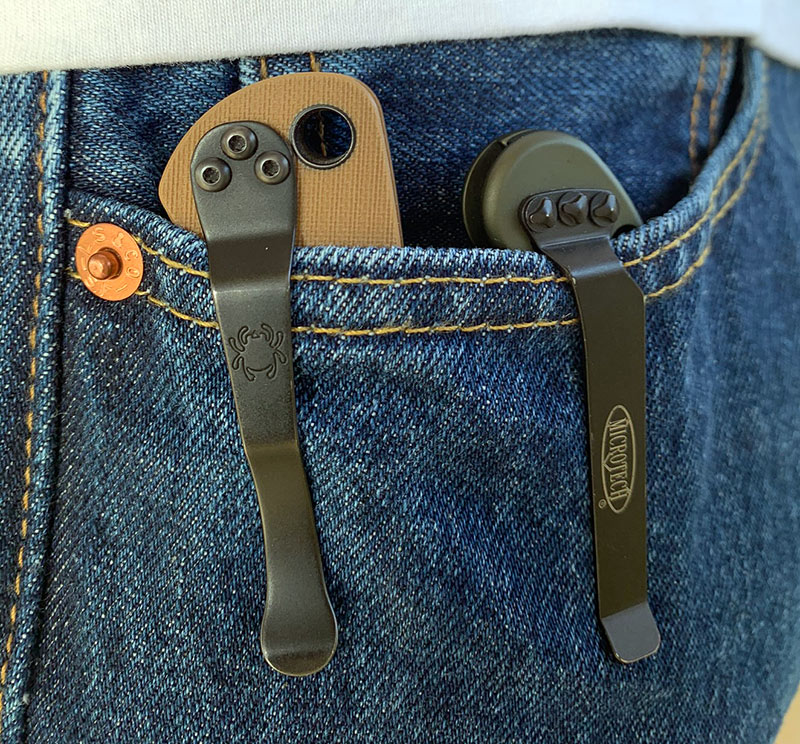We independently evaluate all recommended products and services. Any products or services put forward appear in no particular order. If you click on links we provide, we may receive compensation.
Most of us probably won’t get the chance to go on a search and rescue mission to ensure the safety of human life, but the Microtech LUDT isn’t just for hardcore Navy SEALS, or the original UDT Frogmen. It’s still a very capable EDC knife for general use and everyday working people. It’s got an incredibly good blade, subdued look, snappy automatic action, and surprisingly good ergos. Let’s dive in and take a deeper look.

Key Specs: Microtech LUDT
The Blade
Microtech is well know for making high quality knives at a fair price, with a tactical spin. But the LUDT doesn’t exude the same level of highly tactical looks; rather, it lends itself to a slightly different style of subtlety. And the blade is the center of that design language. With 3.375” of 204p steel, and a grind that is superb, it’s about as good a blade one could design for EDC use, in my opinion. 3” blades tend to have a small enough cutting edge that they lose the ability to swing into the food prep arena, and 4” blades can feel unwieldy for most EDC tasks. Of course these are subjective aspects of pocket knives, but I think between the 3 and 3.5” marks are just right.

A crowned spine, meaning one that is rounded rather than flat on the top of the blade, is generally reserved for higher end knives, like the classic Sebenza. But Microtech decided to add this slick attribute to the LUDT, and it’s great. Maybe not in a functional viewpoint, but it adds a level of quality and perceived value that justifies its price point. And as the crowned spine terminates near the handle, we have a very comfortable, and again subdued jimping. It’s the type of texturing that gives a good purchase, without too much abrasion to your thumb.
Available in a few finishes, our test unit was the coated variant. The stonewashed finish and 2 tone finish are also available, depending on your taste and preference. The finish is similar to what you’d feel on a Spyderco DLC coated blade. It does create a small amount of drag in certain materials, but I think it looks really good, especially on the green handle. And, along with a decent coating, is the infamous Microtech billboarding. They seem to laser etch their blades on one side, in quite a loud manner. It honestly doesn’t bother me, I think it has a cool look to it, but some people disagree.
Deployment/lockup
Of course, with a side opening automatic, the deployment is very snappy. The button, located on the side of the handle, is depressed to fire the blade out the side of the handle. And when I say it fires out, I mean it. I’ve handled a few autos, but Microtech seems to use a pretty heavy spring. Speaking of the button, it’s nicely recessed into the handle, helping to avoid the button being accidentally pressed while being carried. Pressing the button takes an intentional press, especially under the pressure of the spring. It’s done very well, and gave me no problems in any testing I applied.

Lockup is solid on this knife. The button doubles as the lock when the knife is open, and it seems very strong. There’s a great YouTube video of a torture test to the LUDT, and hammering on the handle to test the lock with the blade open posed no issue; the blade stayed locked open reliably. Of course, if your pivot was too loose or too tight, you’d be in a bit of a predicament, considering Microtech’s decision to keep the proprietary hardware on this knife. But, with a strong lockup, and an action that kicks like a mule, this one is good to go.
Firing the blade underwater actually works. I’ve seen an example of this online somewhere, and gave it a go myself. Using a bucket of water, I dunked the knife in, fully submerging it. After all, this is where this knife was designed to be used, right? Of course pressing the button is no issue, and the blade fires hard enough to reliably lock open time after time, even underwater. And this Large UDT knife was at home. Closing the blade isn’t as easy as opening it, of course. It’s more of a two-handed affair, which is neutral to some people, but puts me off a little. I like to be able to close my knife as easily (even if it’s not as quickly) as I open it.
Features, fit and finish
As mentioned before, the blade features a 204p composition, which is very similar to M390 and 20CV. It’s a steel that’s well regarded as today’s most well rounded higher end steel. It’s got decent toughness, great wear resistance, very good stainless properties, and sharpens fairly easily, assuming you’re using the proper sharpening mediums (diamond based stones). I’ll admit, I’m a tool steel guy at heart, with their ability to take an extremely keen edge and hold it for quite a long time. But, as far as stainless steels go, it’s definitely one of my favorites.

The handle made of an anodized 6061 T6 aluminum. I personally think aluminum is a good handle material for a folder. It’s somewhat durable, has a nice texture platform, and retains a fairly light weight. It has three grooves running down each side of the handle, for some purchase, without excessive jimping (Spyderco, I’m looking at you here). There is a small amount of jimping, but it’s done in a way that stays out of the way until you need it, and holds your hand in place when you grip it tighter.
The handle also has another feature to it, that’s almost hidden. The Socom Elite shares this particular feature, and I really wish other mid-to-high end folders would incorporate this into their handle designs. It’s tapered, with the portion closest to the blade being thicker, and the butt of the handle being thinner. It’s very subtle. You probably wouldn’t notice it if you didn’t spend some time looking at the knife with scrutiny, or spending a good amount of time holding and using the knife. The handle also houses multiple proprietary screws. We’ll get into that more a little later, but I’ll admit to it being something that really is frustrating to me.

The LUDT is finished very well. The crowned spine, the edges of the handle, the finish of the blade, and the overall sleek profile is all polished and smooth. There’s not a sharp spot on the knife, save for the blade edge. It’s pleasant to hold and use, and has a great overall feel of quality.
Field test
Back to that tapered handle. It may not seem like a significant design feature, but what it does in use, is great. In light use, like food prep or making some thin feather sticks, it’s not really a help or hindrance. But, give it a solid tight grip, and try to cut heavily into a 2×4, or a 3x thick sheet of cardboard, and you’ll be pleasantly surprised that your pinky isn’t met with a mean hot spot. When I check this on my large Chris Reeve Knives, the Inkosi and Umnumzaan in particular, the lock bar cutout is sharp on the inside of my pinky. Maybe that’s just the nature of some frame locks, but for me, it’s something to note.

One issue I do have with the handle is the hump that houses the spring and button assembly. I understand the design of the handle, especially on an automatic, is dictated in part by the pivot and spring. But on the LUDT, it seems more extreme than in most other comparable knives. The hump is quite large, and forces your hand to be positioned far from the base of the blade edge.
This creates a pivot point in ergonomics that takes leverage power away from your hand, particularly in a hammer grip. I understand that most of us, most of the time, will use a more traditional saber grip, with the thumb on the jimping of the spine. But I do like to use a full hammer grip from time to time, and with the LUDT, it does have a feeling of less control than I’m used to. Not a deal breaker, and with the tapered handle, it’s something that can be forgiven. But it is noteworthy nonetheless.
Speaking of cutting a 2×4, this is one of my favorite knives for harder cutting. I dug into a 2×4 for few minutes, not holding back much. The edge bites well into the material, partly because of the nice factory edge on the blade, but also because of the very thin grind. The blade stock is 0.13”, but the thickness behind the edge is very thin. This aids in starting a cut, quickly moving material out of the way, and keeping a medium thickness to the blade stock for overall durability. This blade looks very plain and almost boring, and I love it. I honestly think it’s one of the few best ground blades of any folder available, in any price range.

The apple slice test is one I always check on a folder. It’s cheap, and gives a good indication of the blade geometry. The LUDT has great bite starting the cut into the skin of the apple, and sliced easily. But, it did present some cracking in the apple slices. I assume this is due to the blade geometry having a quick transition from very thin, to moderately thick. Of course this is all a simple test, and not all knives are made with a food prep design philosophy.
Cardboard cutting is another thing it seems that a lot of us throw at our folders. Can it cut some cardboard just like any other knife? Of course. The coating on the blade seemed to act like that of Spyderco’s DLC, meaning it creates a little extra drag and friction. But, thanks again to a thin grind near the edge, cardboard seems to part like a hot knife through butter in standard cardboard. The double, or triple thick material, definitely gave me a little reminder that I wasn’t using a super thin hollow ground blade, but it wasn’t unmanageable.

Taking down a knife that I carry is important to me. I clean and lube my carry knives as necessary. But with the LUDT, along with Microtech’s OTF knives, there is proprietary hardware. And I don’t mean standard security bits, I mean real proprietary. So, you have a loose pivot? Send the knife in. Your pocket clip got bent a little? Send the knife in. Your action is too dirty and a little wash under the sink won’t fix it? Send the knife in. For maybe 8 weeks. This seriously bothers me, and I have to admit, that’s a deal breaker. I take my knives down often, and adjust them as necessary. I can’t stand just leaving it dirty and never adjusting anything. But, it’s an auto, and their decision makes sense, likely to keep the less experienced users from mucking things up in disassembly.
Alternatives
All these knives available at BladeHQ.
Coming in at a very comparable price, the Benchmade CLA is a worth alternative to the LUDT. It has a very similar blade length (3.4” vs the LUDT’s 3.375”), similar weight (3.47 oz vs the LUDT’s 3.62), and a similar price. The LUDT retails for $258, and the CLA retails for $225. The CLA is also a side opening auto, with a plunge lock, and a optional coated blade. The CLA’s blade steel is 154cm, which is not a powdered steel, and is known for great toughness, but not the best wear resistance.
The CLA also features a safety to lock the button from accidental deployment, so if that’s a must-have on an auto for you, this would be a great alternative. The CLA also allows the user’s grip to be much closer to the blade than that of the LUDT, which may be another deciding factor for some users. The handle material found on the CLA (composite lite auto) is G10, differing from the LUDT once again. With Benchmade’s notoriously good warranty, the CLA is sure to be a worthy opponent to the LUDT.
Circling back around to Microtech, the Socom Elite is a knife that could be viewed as an alternative to the LUDT. It is much bigger, with a 4” blade, comes in a coated or non coated blade, serrated or plain edge, and automatic or manual. And that’s where I truly believe the LUDT loses a lot of perspective buyers. If Microtech offers the Socom in manual or auto, why not the LUDT? Seems to me that they’d sell a whole lot more of them, given the potential legal issues for many users in terms of carrying an automatic knife. I personally know a couple guys who have said they’d own the LUDT if it was available in manual, not only for legal reasons, but just for the freedom of a free dropping blade when it’s unlocked.

Fighting an auto’s spring to close the blade can be a little frustrating, and quite honestly a little less safe, using force to close a blade back toward your hand. But I digress. The Socom Elite is a great large knife (check out our review on it here as well), comes in at a little higher price point ($290 retail on the autos), but retains the same M390 / 204p blade steels (Microtech switches freely between these steels between production runs). The Socom surprisingly keeps the weight relatively low, at 4.58oz, which is almost half an ounce lighter than a Sebenza, just for reference. And, wait for it, the Socom uses standard torx head screw construction, allowing users to service their own knives. Aluminum handles are found again here on the Socom, and with an action that’s just as assertive as the LUDT, it’s sure to win over the hearts of large-knife users.
And visiting another stop in the Microtech house, there’s the Ultratech. Obviously differing from the LUDT in one major aspect, the Ultratech is an OTF (out the front) automatic. And, it’s a dual action, meaning automatic opening and closing, by the switch of the button. The Ultratech does jump up to almost the same price as the Socom mentioned above, at $280, but it does keep some similar specs to the LUDT. The blade comes in a myriad of optional styles, from drop point, tanto, single edge, double edge (be very careful with legalities on this particular aspect), and a few different blade finishes as well.

The blade is 3.125” long and has the same blade steels as the other Microtech’s we’ve talked about here. At 3.45oz, and a blade thickness of 0.13”, it has some close resemblance to the LUDT, save for a much narrower blade. This is of course due to the insanity of springs and linkage systems under the hood of the handle that allow the blade to be automatically deployed and closed. Is it a worthy sacrifice to have a narrower blade? We’ll leave that up to you to decide. But the Ultratech is a staple in the Microtech line, and could be easily viewed as an alternative to the LUDT.
Conclusion
The Microtech LUDT is undoubtedly a great knife. The blade is one of the most versatile, simple, and usable of any folder I’ve handled. Coupled with a very capable grind, and a top-tier steel, it doesn’t get much better in terms of a well rounded blade. Using the knife in common, daily tasks proved to be enjoyable and comfortable, until I had to close the knife. For my personal use, the automatic just hinders me from putting the knife away just as quickly as I retrieved it. And with a pivot housing that is shaped just awkwardly enough to force my hand too far from the cutting edge, paired with proprietary hardware, I just couldn’t get myself to carry this knife for an extended period.

If Microtech could go to the same Torx based hardware as the Socom Elite, and toss in a manual option, I could deal with the distant hand position in relation to the blade. But, if what you’re after is a reliable, hard hitting auto, with an incredibly useful blade, this one is a great option.
- Carries well, exceptional blade, hard-firing auto geared toward edc/tactical use.
- Hit or miss ergos, proprietary hardware prevents self service, no manual option.
Microtech LUDT
Quality/Performance - 75%
Value for Money - 78%
77%
The LUDT is a reliable, hard hitting auto, with an incredibly useful blade.





